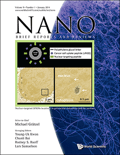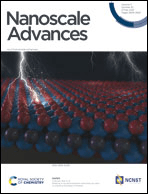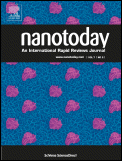
NANO
Scope & Guideline
Unveiling the Potential of Nanoscale Research
Introduction
Aims and Scopes
- Nanomaterials and Nanostructures:
Research on the synthesis, characterization, and applications of various nanomaterials, including metals, semiconductors, and polymers, focusing on their unique properties at the nanoscale. - Nanomedicine and Drug Delivery:
Exploration of nanotechnology in biomedical applications, particularly in targeted drug delivery systems, therapeutic nanoparticles, and the design of nanovaccines for enhanced treatment efficacy. - Energy Storage and Conversion:
Studies on nanotechnology's role in improving energy storage systems, such as lithium-ion and sodium-ion batteries, as well as nanomaterials used in solar cells and fuel cells. - Environmental Applications:
Research on the use of nanoscale materials and technologies in environmental remediation, pollution control, and sustainable energy solutions. - Nanoelectronics and Photonics:
Investigation of nanoscale electronic devices, photonic materials, and their applications in sensors, transistors, and optoelectronic devices. - Advanced Characterization Techniques:
Development and application of novel techniques for the analysis and characterization of nanomaterials, including imaging and spectroscopic methods.
Trending and Emerging
- Nanotechnology for Cancer Therapy:
A significant rise in research related to the use of nanotechnology in cancer treatment, including nanovaccines, targeted drug delivery systems, and photothermal therapies. - Sustainable and Green Nanotechnology:
Growing interest in environmentally friendly nanomaterials and processes, emphasizing sustainability, recycling, and the reduction of waste in nanotechnology applications. - Artificial Intelligence in Nanotechnology:
The integration of AI and machine learning techniques to optimize nanomaterial design, synthesis processes, and predictive modeling of nanomaterials' behavior. - Nanomaterials for Energy Applications:
Increased research on advanced nanomaterials for energy harvesting, storage, and conversion, particularly in batteries, supercapacitors, and solar cells. - Wearable and Flexible Electronics:
Emerging focus on the development of nanomaterials for flexible and wearable electronic devices, driven by advances in health monitoring and smart textiles. - Nano-Optoelectronics:
Enhanced research into optoelectronic devices at the nanoscale, including photodetectors, light-emitting diodes, and sensors that leverage nanoscale phenomena.
Declining or Waning
- Traditional Nanocomposites:
Research on standard polymer nanocomposites has decreased as new materials and methods, such as bioinspired and hybrid nanocomposites, gain more attention. - Basic Studies on Nanoparticle Toxicity:
The focus on the generic toxicity of nanoparticles is waning, giving way to more targeted studies that explore specific interactions with biological systems. - Nanotechnology in Agriculture:
Interest in the application of nanotechnology in agriculture, particularly regarding pesticide delivery systems, appears to be decreasing as alternative approaches are explored. - Simple Nanostructure Fabrication Techniques:
The prevalence of basic fabrication methods for nanostructures is declining as researchers seek more sophisticated and scalable techniques that offer better control over material properties.
Similar Journals

Energy Materials
Innovating Materials for a Greener Tomorrow.Energy Materials is a pioneering journal published by OAE PUBLISHING INC, dedicated to the dynamic field of energy materials science and engineering. With a focus on advancing knowledge related to materials used in various energy applications such as batteries, fuel cells, and solar cells, this open-access journal aims to disseminate cutting-edge research and innovative methodologies to a global audience. By offering a platform for original research, reviews, and case studies, Energy Materials plays a crucial role in bridging the gap between materials science and energy technology, facilitating the development of sustainable energy solutions. Researchers, professionals, and students alike will find invaluable insights in its pages, fostering advancements in this essential sector. To explore the latest developments in energy materials, visit Energy Materials at OAE PUBLISHING INC.

Advances in Nano Research
Transforming Ideas into Nano SolutionsAdvances in Nano Research, published by TECHNO-PRESS, is a prominent academic journal dedicated to advancing knowledge across various facets of nanoscience and nanotechnology. With its ISSN of 2287-237X and E-ISSN 2287-2388, this journal serves as a vital resource for researchers and professionals, focusing on areas such as Atomic and Molecular Physics, Biotechnology, Catalysis, Ceramics and Composites, and Electrical Engineering. Since its inception in 2017, the journal has notably achieved Q2 ranking in multiple categories for the year 2023, reflecting its commitment to high-quality research dissemination and its increasing influence in Scopus rankings, including ranks within the top 12% in Chemical Engineering. While Open Access options are currently unavailable, the rigorous peer-review process ensures that only the most impactful studies are published, further solidifying its importance within the academic community. As a significant player in the fields of engineering and materials science, Advances in Nano Research aims to foster innovation and collaboration, making it an essential publication for those engaged in cutting-edge research and development within the realm of nanotechnology.

Nanoscale Advances
Transforming Ideas into Nanoscale Innovations.Nanoscale Advances, published by the Royal Society of Chemistry, stands out as a leading open-access journal dedicated to advancing the field of nanoscience and nanotechnology since its inception in 2018. With a specialized focus on areas such as atomic and molecular physics, bioengineering, chemistry, and materials science, this journal has consistently achieved top-tier rankings across several categories, reflecting its high-impact contribution to research and innovation. Currently classified in the Q1 quartile for both Atomic and Molecular Physics and Chemistry (Miscellaneous), and Q2 for Bioengineering, its prestige is underscored by impressive Scopus rankings, including a notable 34th position in General Engineering. With its commitment to disseminating high-quality research, Nanoscale Advances serves as an invaluable resource for researchers, professionals, and students alike, fostering collaboration and scholarly exchange in the rapidly evolving landscape of nanotechnology.

Journal of Physical Chemistry C
Elevating understanding in the realm of physical chemistry.The Journal of Physical Chemistry C, published by the American Chemical Society, stands as a pivotal resource in the realm of materials science and physical chemistry. With an impact factor reflecting its esteemed reputation, this journal showcases high-quality research spanning topics such as electronic, optical, and magnetic materials, as well as nanoscience and nanotechnology. Hailing from the United States, it operates without an open access model, yet its contributions are critical for advancing our understanding of surfaces, coatings, and films. Notably, the journal is classified in Quartile 1 (Q1) for several categories, underscoring its prominence in Physical and Theoretical Chemistry and related fields. Researchers, professionals, and students alike will find value in the comprehensive discussions and innovative research trends presented. The scholarly articles published from 2007 to 2024 not only drive forward scientific inquiry but also inform practical applications in various industries, making this journal an essential tool for anyone committed to excellence in the sciences.

Energy Material Advances
Elevating the Future of Energy MaterialsEnergy Material Advances, published by the American Association for the Advancement of Science, stands at the forefront of energy research, showcasing groundbreaking studies in the realm of renewable energy, fuel technology, and materials science. With the journal's commitment to open access since 2020, it aims to democratize knowledge and foster innovation across a global community of researchers, professionals, and students. The journal boasts an impressive impact factor, placing it firmly within the Q1 category across multiple disciplines including Energy (miscellaneous), Fuel Technology, and Renewable Energy, Sustainability and the Environment, highlighting its significance in advancing scholarly discussions. In the latest Scopus rankings, Energy Material Advances ranks among the top 10% of journals in its field, affirming its role as a pivotal resource for current and emerging trends in energy materials. The journal is dedicated to facilitating collaborative efforts and inspiring novel approaches to the challenges posed by energy sustainability and technological advancement.

AIP Advances
Innovating Research, Connecting Disciplines.AIP Advances, published by AIP Publishing in the United States, is an esteemed open-access journal that has been pivotal in disseminating knowledge in the fields of Nanoscience and Nanotechnology and Physics and Astronomy since its inception in 2011. With an unwavering commitment to enhancing global scientific communication, the journal provides a platform for groundbreaking research and innovative methodologies, catering to a diverse audience of researchers, practitioners, and students. As of 2023, AIP Advances enjoys a respectable impact factor that reflects its significance in the academic community, ranking in the Q3 category for both Nanoscience and Nanotechnology and Physics and Astronomy. The journal has made its contributions accessible, reinforcing its mission of promoting collaboration and knowledge sharing across disciplines. Researchers interested in publishing their work will find AIP Advances not only a valuable medium for their findings but also a hub for the latest advancements and discussions shaping these dynamic fields.

Nano Today
Connecting scholars to the latest breakthroughs in nanotechnology.Nano Today is a prestigious journal published by ELSEVIER SCI LTD that stands at the forefront of nanoscience and nanotechnology research. With an impact factor that underscores its significance, this journal has achieved remarkable rankings in several key categories as of 2023, including Q1 positions in Bioengineering, Biomedical Engineering, Biotechnology, Materials Science, and Pharmaceutical Science, making it an essential resource for scholars and professionals alike. ISSN 1748-0132 and E-ISSN 1878-044X, the journal serves as a vital platform for disseminating cutting-edge research findings and innovative applications in the field. Although open access options are not available, the journal's rich repository of peer-reviewed articles provides invaluable insights into the latest advancements in nanotechnologies. Based in the Netherlands, Nano Today not only connects a global network of researchers but also propels forward the conversation on the transformative potential of nanomaterials across multiple disciplines. With a commitment to advancing knowledge and fostering innovation, Nano Today is an indispensable tool for academics and practitioners dedicated to pushing the boundaries of scientific exploration.

Nanoscale Research Letters
Advancing the frontiers of nanoscience.Nanoscale Research Letters, published by SPRINGER, is a leading open-access journal dedicated to the rapid dissemination of innovative research in the field of nanoscience and nanotechnology. Established in 2006, this journal provides researchers and professionals with a platform to share their groundbreaking findings across a broad spectrum of applications, including condensed matter physics and materials science. With an impressive Q1 ranking in both Condensed Matter Physics and Materials Science categories as of 2023, it asserts its position as a top-tier publication within the scientific community, bolstered by a 96th percentile rank in the Scopus database. Nanoscale Research Letters not only emphasizes the importance of nanotechnology research but also ensures that its findings are widely accessible, adhering to its open-access mandate. Scholars and students alike are encouraged to contribute to and engage with this dynamic resource, fostering collaboration and innovation in the ever-evolving world of nanoscience.

Discover Nano
Pioneering Discoveries in the World of NanomaterialsDiscover Nano is a pioneering journal published by SPRINGER, dedicated to the rapidly evolving field of nanoscience and nanotechnology. Established in 2023, this innovative platform provides an open-access forum for researchers, professionals, and students to share and disseminate cutting-edge findings in materials science and condensed matter physics. With its commitment to accessibility, Discover Nano encourages a broad spectrum of contributions, aiming to foster collaboration and stimulate discussion in this dynamic area of study. As a new entry into the academic community, the journal holds great potential for growth, aspiring to increase its visibility and impact in the materials science arena, where it currently ranks in the bottom quartile for both materials science and physics categories. Based in Germany and reaching a global audience, Discover Nano represents a significant opportunity for those looking to shape the future of nanotechnology through impactful research and interdisciplinary dialogue.

Carbon Energy
Pioneering pathways to sustainable energy practices.Welcome to Carbon Energy, an esteemed open-access journal published by WILEY that focuses on cutting-edge research in the field of energy and materials science. Since its inception in 2019, this journal has quickly established itself as a leading platform for disseminating impactful findings and innovations related to carbon-based energy solutions, renewable resources, and sustainability practices. With its impressive Q1 rankings in multiple categories—including Energy (miscellaneous), Materials Chemistry, and Renewable Energy—Carbon Energy is recognized for delivering high-quality, peer-reviewed content that meets the rigorous standards of the academic community. Through its open-access model, the journal ensures wide accessibility of research findings, making it an invaluable resource for researchers, professionals, and students alike. As we look toward the future, Carbon Energy aims to further its mission of advancing sustainable energy technologies and promoting interdisciplinary collaboration in tackling global energy challenges.